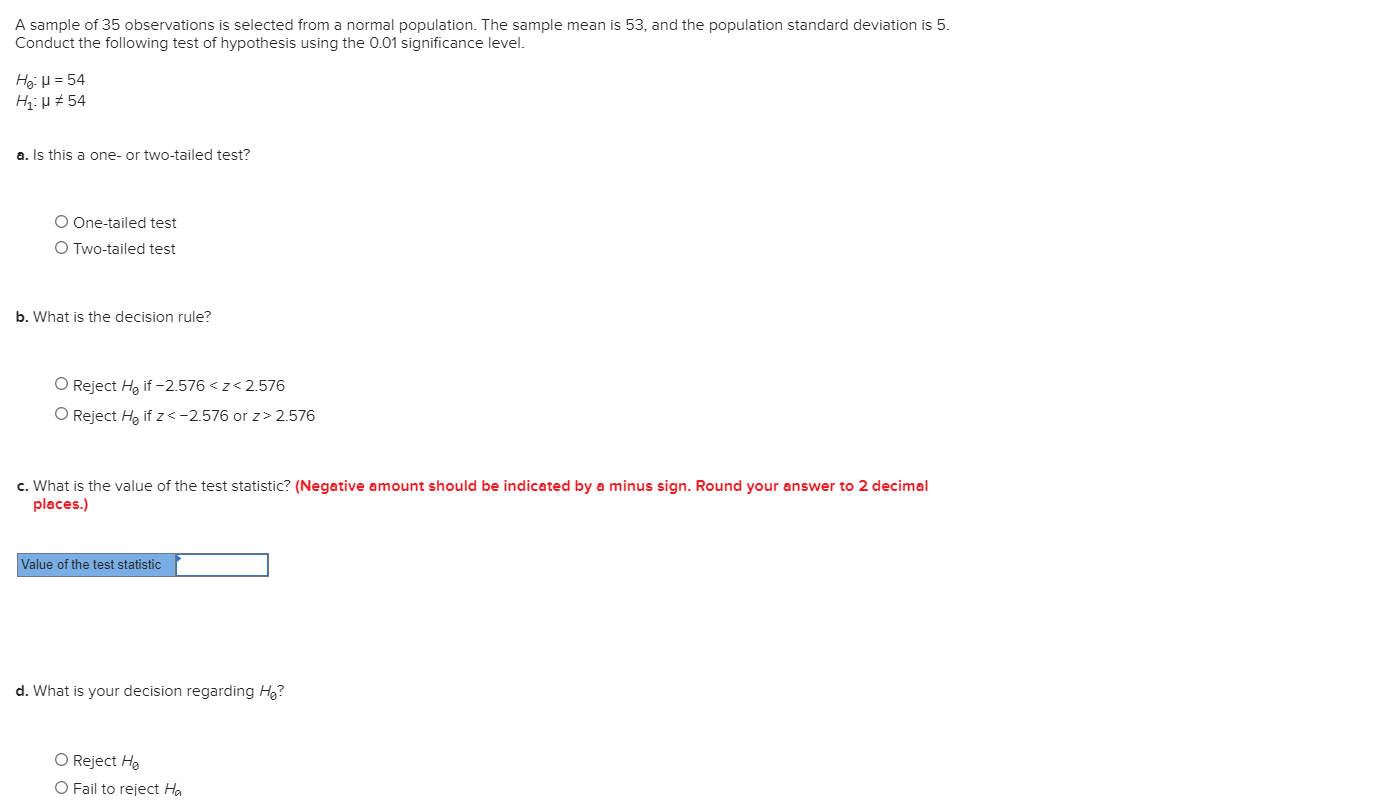A sample of 35 observations is selected from a normal population. The sample mean is 53, and the population standard deviation is 5. Conduct the following test of hypothesis using the 0.01 significance level. Họ: H = 54 H: µ # 54 a. Is this a one- or two-tailed test? O One-tailed test O Two-tailed test b. What is the decision rule? O Reject H, if -2.576 < z< 2.576 O Reject H, if z<-2.576 or z> 2.576 c. What is the value of the test statistic? (Negative amount should be indicated by a minus sign. Round your answer to 2 decimal places.) Value of the test statistic
A sample of 35 observations is selected from a normal population. The sample mean is 53, and the population standard deviation is 5. Conduct the following test of hypothesis using the 0.01 significance level. Họ: H = 54 H: µ # 54 a. Is this a one- or two-tailed test? O One-tailed test O Two-tailed test b. What is the decision rule? O Reject H, if -2.576 < z< 2.576 O Reject H, if z<-2.576 or z> 2.576 c. What is the value of the test statistic? (Negative amount should be indicated by a minus sign. Round your answer to 2 decimal places.) Value of the test statistic
MATLAB: An Introduction with Applications
6th Edition
ISBN:9781119256830
Author:Amos Gilat
Publisher:Amos Gilat
Chapter1: Starting With Matlab
Section: Chapter Questions
Problem 1P
Related questions
Topic Video
Question

Transcribed Image Text:A sample of 35 observations is selected from a normal population. The sample mean is 53, and the population standard deviation is 5.
Conduct the following test of hypothesis using the 0.01 significance level.
Họ: H = 54
H: µ # 54
a. Is this a one- or two-tailed test?
O One-tailed test
O Two-tailed test
b. What is the decision rule?
O Reject H, if -2.576 < z< 2.576
O Reject H, if z<-2.576 or z> 2.576
c. What is the value of the test statistic? (Negative amount should be indicated by a minus sign. Round your answer to 2 decimal
places.)
Value of the test statistic

Expert Solution
This question has been solved!
Explore an expertly crafted, step-by-step solution for a thorough understanding of key concepts.
This is a popular solution!
Trending now
This is a popular solution!
Step by step
Solved in 3 steps with 5 images

Knowledge Booster
Learn more about
Need a deep-dive on the concept behind this application? Look no further. Learn more about this topic, statistics and related others by exploring similar questions and additional content below.Recommended textbooks for you

MATLAB: An Introduction with Applications
Statistics
ISBN:
9781119256830
Author:
Amos Gilat
Publisher:
John Wiley & Sons Inc

Probability and Statistics for Engineering and th…
Statistics
ISBN:
9781305251809
Author:
Jay L. Devore
Publisher:
Cengage Learning

Statistics for The Behavioral Sciences (MindTap C…
Statistics
ISBN:
9781305504912
Author:
Frederick J Gravetter, Larry B. Wallnau
Publisher:
Cengage Learning

MATLAB: An Introduction with Applications
Statistics
ISBN:
9781119256830
Author:
Amos Gilat
Publisher:
John Wiley & Sons Inc

Probability and Statistics for Engineering and th…
Statistics
ISBN:
9781305251809
Author:
Jay L. Devore
Publisher:
Cengage Learning

Statistics for The Behavioral Sciences (MindTap C…
Statistics
ISBN:
9781305504912
Author:
Frederick J Gravetter, Larry B. Wallnau
Publisher:
Cengage Learning

Elementary Statistics: Picturing the World (7th E…
Statistics
ISBN:
9780134683416
Author:
Ron Larson, Betsy Farber
Publisher:
PEARSON

The Basic Practice of Statistics
Statistics
ISBN:
9781319042578
Author:
David S. Moore, William I. Notz, Michael A. Fligner
Publisher:
W. H. Freeman

Introduction to the Practice of Statistics
Statistics
ISBN:
9781319013387
Author:
David S. Moore, George P. McCabe, Bruce A. Craig
Publisher:
W. H. Freeman